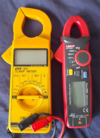- Joined
- 27 Jan 2008
- Messages
- 27,547
- Reaction score
- 3,329
- Location
- Llanfair Caereinion, Nr Welshpool
- Country

I have had a clamp on multi meter for years, but only one decimal point and only AC.
 So at long last I have a meter to measure mA and DC. So testing measured the charge rate on battery charger, and combined neutral and line incomers and DC at incomer.
So at long last I have a meter to measure mA and DC. So testing measured the charge rate on battery charger, and combined neutral and line incomers and DC at incomer.
Leakage seems between 18 mA and 21 mA but this is all 14 RCBO's so seems OK, and DC component shows as around 10 mA higher than expected. Battery charger was as expected so readings seem to be within what is expected, but other than leakage normally less than 30 mA as above that would trip a RCD in a home with only two, I have never before actually measured it.
I did find on DC range important to select range and press zero first, but with meters I have used in the past one started to get a knowledge of what to expect, so when you saw 1M Ω even if a pass, you know that is rather low, and one looks at why, same doing earth rods, expect a single rod around 60 Ω so if you read 2 Ω one looks for a water or gas pipe not disconnected for the test.
So want to know what is a normal reading, I would have said over 9 mA leakage the supply needs splitting into multi RCD's but only test in past was if the RCD tester tripped at ½ rated current I assumed some thing wrong.
 So at long last I have a meter to measure mA and DC. So testing measured the charge rate on battery charger, and combined neutral and line incomers and DC at incomer.
So at long last I have a meter to measure mA and DC. So testing measured the charge rate on battery charger, and combined neutral and line incomers and DC at incomer.Leakage seems between 18 mA and 21 mA but this is all 14 RCBO's so seems OK, and DC component shows as around 10 mA higher than expected. Battery charger was as expected so readings seem to be within what is expected, but other than leakage normally less than 30 mA as above that would trip a RCD in a home with only two, I have never before actually measured it.
I did find on DC range important to select range and press zero first, but with meters I have used in the past one started to get a knowledge of what to expect, so when you saw 1M Ω even if a pass, you know that is rather low, and one looks at why, same doing earth rods, expect a single rod around 60 Ω so if you read 2 Ω one looks for a water or gas pipe not disconnected for the test.
So want to know what is a normal reading, I would have said over 9 mA leakage the supply needs splitting into multi RCD's but only test in past was if the RCD tester tripped at ½ rated current I assumed some thing wrong.
